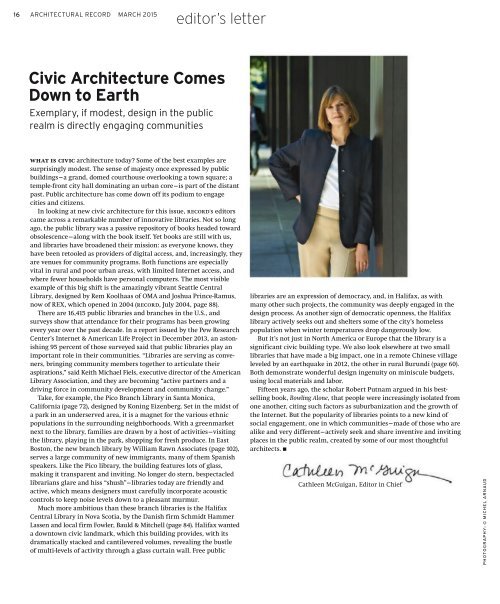Architectural Record 2015-03
You also want an ePaper? Increase the reach of your titles
YUMPU automatically turns print PDFs into web optimized ePapers that Google loves.
16<br />
ARCHITECTURAL RECORD MARCH <strong>2015</strong><br />
editor’s letter<br />
Civic Architecture Comes<br />
Down to Earth<br />
Exemplary, if modest, design in the public<br />
realm is directly engaging communities<br />
what is civic architecture today? Some of the best examples are<br />
surprisingly modest. The sense of majesty once expressed by public<br />
buildings—a grand, domed courthouse overlooking a town square; a<br />
temple-front city hall dominating an urban core—is part of the distant<br />
past. Public architecture has come down off its podium to engage<br />
cities and citizens.<br />
In looking at new civic architecture for this issue, record’s editors<br />
came across a remarkable number of innovative libraries. Not so long<br />
ago, the public library was a passive repository of books headed toward<br />
obsolescence—along with the book itself. Yet books are still with us,<br />
and libraries have broadened their mission: as everyone knows, they<br />
have been retooled as providers of digital access, and, increasingly, they<br />
are venues for community programs. Both functions are especially<br />
vital in rural and poor urban areas, with limited Internet access, and<br />
where fewer households have personal computers. The most visible<br />
example of this big shift is the amazingly vibrant Seattle Central<br />
Library, designed by Rem Koolhaas of OMA and Joshua Prince-Ramus,<br />
now of REX, which opened in 2004 (record, July 2004, page 88).<br />
There are 16,415 public libraries and branches in the U.S., and<br />
surveys show that attendance for their programs has been growing<br />
every year over the past decade. In a report issued by the Pew Research<br />
Center’s Internet & American Life Project in December 2013, an astonishing<br />
95 percent of those surveyed said that public libraries play an<br />
important role in their communities. “Libraries are serving as conveners,<br />
bringing community members together to articulate their<br />
aspirations,” said Keith Michael Fiels, executive director of the American<br />
Library Association, and they are becoming “active partners and a<br />
driving force in community development and community change.”<br />
Take, for example, the Pico Branch Library in Santa Monica,<br />
California (page 72), designed by Koning Eizenberg. Set in the midst of<br />
a park in an underserved area, it is a magnet for the various ethnic<br />
populations in the surrounding neighborhoods. With a greenmarket<br />
next to the library, families are drawn by a host of activities—visiting<br />
the library, playing in the park, shopping for fresh produce. In East<br />
Boston, the new branch library by William Rawn Associates (page 102),<br />
serves a large community of new immigrants, many of them Spanish<br />
speakers. Like the Pico library, the building features lots of glass,<br />
making it transparent and inviting. No longer do stern, bespectacled<br />
librarians glare and hiss “shush”—libraries today are friendly and<br />
active, which means designers must carefully incorporate acoustic<br />
controls to keep noise levels down to a pleasant murmur.<br />
Much more ambitious than these branch libraries is the Halifax<br />
Central Library in Nova Scotia, by the Danish firm Schmidt Hammer<br />
Lassen and local firm Fowler, Bauld & Mitchell (page 84). Halifax wanted<br />
a downtown civic landmark, which this building provides, with its<br />
dramatically stacked and cantilevered volumes, revealing the bustle<br />
of multi-levels of activity through a glass curtain wall. Free public<br />
libraries are an expression of democracy, and, in Halifax, as with<br />
many other such projects, the community was deeply engaged in the<br />
design process. As another sign of democratic openness, the Halifax<br />
library actively seeks out and shelters some of the city’s homeless<br />
population when winter temperatures drop dangerously low.<br />
But it’s not just in North America or Europe that the library is a<br />
significant civic building type. We also look elsewhere at two small<br />
libraries that have made a big impact, one in a remote Chinese village<br />
leveled by an earthquake in 2012, the other in rural Burundi (page 60).<br />
Both demonstrate wonderful design ingenuity on miniscule budgets,<br />
using local materials and labor.<br />
Fifteen years ago, the scholar Robert Putnam argued in his bestselling<br />
book, Bowling Alone, that people were increasingly isolated from<br />
one another, citing such factors as suburbanization and the growth of<br />
the Internet. But the popularity of libraries points to a new kind of<br />
social engagement, one in which communities—made of those who are<br />
alike and very different—actively seek and share inventive and inviting<br />
places in the public realm, created by some of our most thoughtful<br />
architects. ■<br />
Cathleen McGuigan, Editor in Chief<br />
PHOTOGRAPHY: © MICHEL ARNAUD


















